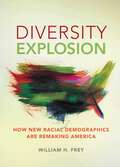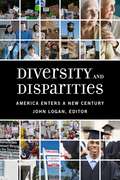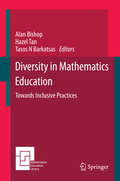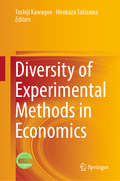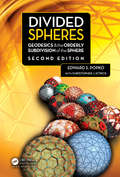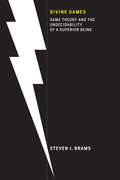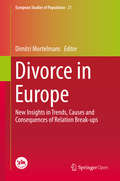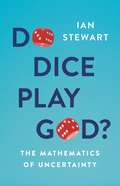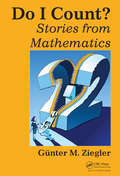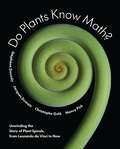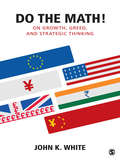- Table View
- List View
Diversity Explosion
by William H. FreyAt its optimistic best, America has embraced its identity as the world's melting pot. Today it is on the cusp of becoming a country with no racial majority, and new minorities are poised to exert a profound impact on U.S. society, economy, and politics. In April 2011 a New York Times headline announced, "Numbers of Children of Whites Falling Fast." As it turns out, that year became the first time in American history that more minority babies than white babies were born. The concept of a "minority white" may instill fear among some Americans, but William H. Frey, the man behind the demographic research, points out that demography is destiny, and the fear of a more racially diverse nation will almost certainly dissipate over time.Through a compelling narrative and eye-catching charts and maps, eminent demographer Frey interprets and expounds on the dramatic growth of minority populations in the United States. He finds that without these expanding groups, America could face a bleak future: this new generation of young minorities, who are having children at a faster rate than whites, is infusing our aging labor force with vitality and innovation.In contrast with the labor force-age population of Japan, Germany, Italy, and the United Kingdom, the U.S. labor force-age population is set to grow 5 percent by 2030. Diversity Explosion shares the good news about diversity in the coming decades, and the more globalized, multiracial country that U.S. is becoming.Contents1. A Pivotal Period for Race in America2. Old versus Young: Cultural Generation Gaps3. America's New Racial Map4. Hispanics Fan Out: Who Goes Where?5. Asians in America: The Newest Minority Surge6. The Great Migration of Blacks--In Reverse7. White Population Shifts--A Zero-Sum Game8. Melting Pot Cities and Suburbs9. Neighborhood Segregation: Toward a New Racial Paradigm10. Multiracial Marriages and Multiracial America11. Race and Politics: Expanding the Battleground12. America on the Cuspics Fan Out: Who Goes Where? 5. Asians in America: Where They Matter Most 6. The Great Migration in Reverse 7. Zero-Sum Game: White Gains and Losses 8. Melting Pot Cities and Suburbs 9. Neighborhood Segregation-Delayed Declines 10. Mixed-Race Marriages and Multicultural America 11. Race and Politics: Red, Blue, and Purple States 12. New Racial Demographics and the Nation's Future
Diversity Explosion
by William H. FreyAt its optimistic best, America has embraced its identity as the world's melting pot. Today it is on the cusp of becoming a country with no racial majority, and new minorities are poised to exert a profound impact on U.S. society, economy, and politics. The concept of a "minority white" may instill fear among some Americans, but William H. Frey, the man behind the demographic research, points out that demography is destiny, and the fear of a more racially diverse nation will almost certainly dissipate over time.Through a compelling narrative and eye-catching charts and maps, eminent demographer Frey interprets and expounds on the dramatic growth of minority populations in the United States. He finds that without these expanding groups, America could face a bleak future: this new generation of young minorities, who are having children at a faster rate than whites, is infusing our aging labor force with vitality and innovation. In contrast with the labor force-age population of Japan, Germany, Italy, and the United Kingdom, the U.S. labor force-age population is set to grow 5 percent by 2030. Diversity Explosion shares the good news about diversity in the coming decades, and the more globalized, multiracial country that the U.S. is becoming.ContentsA Pivotal Period for Race in AmericaOld versus Young: Cultural Generation GapsAmerica's New Racial MapHispanics Fan Out: Who Goes Where?Asians in America: The Newest Minority SurgeThe Great Migration of Blacks-In ReverseWhite Population Shifts-A Zero-SumMelting Pot Cities and SuburbsNeighborhood Segregation: Toward a New Racial ParadigmMultiracial Marriages and Multiracial AmericaRace and Politics: Expanding the BattlegroundAmerica on the Cusp
Diversity and Disparities: America Enters a New Century
by John LoganThe United States is more diverse than ever before. Increased immigration has added to a vibrant cultural fabric, and women and minorities have made significant strides in overcoming overt discrimination. At the same time, economic inequality has increased significantly in recent decades, and the Great Recession substantially weakened the economic standing not only of the poor but also of the middle class. Diversity and Disparities, edited by sociologist John Logan, assembles impressive new studies that interpret the social and economic changes in the United States over the last decade. The authors, leading social scientists from many disciplines, analyze changes in the labor market, family structure, immigration, and race. They find that while America has grown more diverse, the opportunities available to disadvantaged groups have become more unequal. Drawing on detailed data from the decennial census, the American Community Survey, and other sources, the authors chart the growing diversity and the deepening disparities among different groups in the United States Harry J. Holzer and Marek Hlavac document that although the economy always rises and falls over the business cycle, the Great Recession of 2007–2009 was a catastrophic event that saw record levels of unemployment, especially among less-educated workers, young people, and minorities. Emily Rosenbaum shows how the Great Recession amplified disparities in access to home ownership, and demonstrates that young adults, especially African Americans, are falling behind previous cohorts not only in home ownership and wealth but even in starting their own families and households. Sean F. Reardon and Kendra Bischoff explore the rise of class segregation as higher-income Americans are moving away from others into separate and privileged neighborhoods and communities. Immigration has also seen class polarization, with an increase in both highly skilled workers and undocumented immigrants. As Frank D. Bean and his colleagues show, the lack of a path to legal status for undocumented immigrants inhibits the educational and economic opportunities for their children and grandchildren. Barrett Lee and colleagues demonstrate that the nation and most cities and towns are becoming more diverse by race and ethnicity. However, while black-white segregation is slowly falling, Hispanics and Asians remain as segregated today as they were in 1980. Diversity and Disparities raises concerns about the extent of socioeconomic immobility in the United States today. This volume provides valuable information for policymakers, journalists, and researchers seeking to understand the current state of the nation.
Diversity and Non-integer Differentiation for System Dynamics
by Alain OustaloupBased on a structured approach to diversity, notably inspired by various forms of diversity of natural origins, Diversity and Non-integer Derivation Applied to System Dynamics provides a study framework to the introduction of the non-integer derivative as a modeling tool. Modeling tools that highlight unsuspected dynamical performances (notably damping performances) in an "integer" approach of mechanics and automation are also included. Written to enable a two-tier reading, this is an essential resource for scientists, researchers, and industrial engineers interested in this subject area. Table of Contents:1. From Diversity to Unexpected DynamicPerformance.2. The Robustness of Damping.3. Fractional Differentiation and its Memory.4. CRONE Suspension Idea.5. CRONE Control Idea
Diversity in Mathematics Education
by Alan Bishop Hazel Tan Tasos N BarkatsasThis book presents a research focus on diversity and inclusivity in mathematics education. The challenge of diversity, largely in terms of student profiles or contextual features, is endemic in mathematics education, and is often argued to require differentiation as a response. Typically different curricula, text materials, task structures or pedagogies are favoured responses, but huge differences in achievement still result. If we in mathematics education seek to challenge that status quo, more research must be focussed not just on diversity but also on the inclusivity, of practices in mathematics education. The book is written by a group of experienced collaborating researchers who share this focus. It is written for researchers, research students, teachers and in-service professionals, who recognise both the challenges but also the opportunities of creating and evaluating new inclusive approaches to curriculum and pedagogy - ones that take for granted the positive values of diversity. Several chapters report new research in this direction. The authors are part of, or have visited with, the mathematics education staff of the Faculty of Education at Monash University, in Melbourne, Australia. The chapters all focus on the ideas of development in both research and practice, recognising that the current need is for new inclusive approaches. The studies presented are set in different contexts, including Australia, China, the United States, and Singapore.
Diversity in Survey Questions on the Same Topic
by Tineke De Jonge Ruut Veenhoven Wim KalmijnThis book describes why conventional methods fall short to solve the comparability problem and introduces three successive innovations to overcome these shortcomings. Comparability of results from different surveys using different items for the same topic is greatly hampered by the differences in response scales used. This reduces our accumulation of knowledge and has challenged researchers in the field of survey research for long to develop appropriate methods to transform ratings on different scales to attain comparable results and to correct for effects of changes in measurements and other influencing factors. The three innovations described in this volume are applied to data on happiness and life satisfaction, show better comparability of the survey results concerning the perceptions and opinions of people over time and across nations and at an increased opportunity for meta-analysis on these results.
Diversity of Experimental Methods in Economics
by Toshiji Kawagoe Hirokazu TakizawaThis is the first book that examines the diverse range of experimental methods currently being used in the social sciences, gathering contributions by working economists engaged in experimentation, as well as by a political scientist, psychologists and philosophers of the social sciences. Until the mid-twentieth century, most economists believed that experiments in the economic sciences were impossible. But that’s hardly the case today, as evinced by the fact that Vernon Smith, an experimental economist, and Daniel Kahneman, a behavioral economist, won the Nobel Prize in Economics in 2002. However, the current use of experimental methods in economics is more diverse than is usually assumed. As the concept of experimentation underwent considerable abstraction throughout the twentieth century, the areas of the social sciences in which experiments are applied are expanding, creating renewed interest in, and multifaceted debates on, the way experimental methods are used. This book sheds new light on the diversity of experimental methodologies used in the social sciences. The topics covered include historical insights into the evolution of experimental methods; the necessary “performativity” of experiments, i.e., the dynamic interaction with the social contexts in which they are embedded; the application of causal inferences in the social sciences; a comparison of laboratory, field, and natural experiments; and the recent use of randomized controlled trials (RCTs) in development economics. Several chapters also deal with the latest heated debates, such as those concerning the use of the random lottery method in laboratory experiments.
Diversity of Functional Traits and Interactions: Perspectives on Community Dynamics (Theoretical Biology)
by Akihiko MougiThis book presents new theoretical perspectives on ecological community dynamics and in so doing casts fresh light on the enduring complexity–stability debate. Real ecological communities do not simply comprise diverse species and interactions, which respectively represented the nodes and links of the classic network theory. Rather, they are characterized by different types of complexity, and this book explains how this diversity of complexity is key to understanding the dynamics of ecological communities. It is shown how various properties in natural communities, such as life history, adaptation, density dependence, sex, interaction types, space, functional traits, and microbial processes, can dramatically increase the complexity in ecological communities. Furthermore, innovative methods are introduced that may be applied to cast light on very complex communities. With each chapter presenting the latest advances and approaches, the book sets the direction for future research on ecological community dynamics. It will be a “must read” for researchers and students in the field of ecology.
Divided Spheres: Geodesics and the Orderly Subdivision of the Sphere
by Edward S. Popko Christopher J. KitrickPraise for the previous edition [. . .] Dr. Popko’s elegant new book extends both the science and the art of spherical modeling to include Computer-Aided Design and applications, which I would never have imagined when I started down this fascinating and rewarding path. His lovely illustrations bring the subject to life for all readers, including those who are not drawn to the mathematics. This book demonstrates the scope, beauty, and utility of an art and science with roots in antiquity. [. . .] Anyone with an interest in the geometry of spheres, whether a professional engineer, an architect or product designer, a student, a teacher, or simply someone curious about the spectrum of topics to be found in this book, will find it helpful and rewarding.– Magnus Wenninger, Benedictine Monk and Polyhedral Modeler Ed Popko's comprehensive survey of the history, literature, geometric, and mathematical properties of the sphere is the definitive work on the subject. His masterful and thorough investigation of every aspect is covered with sensitivity and intelligence. This book should be in the library of anyone interested in the orderly subdivision of the sphere. – Shoji Sadao, Architect, Cartographer and lifelong business partner of Buckminster Fuller Edward Popko's Divided Spheres is a "thesaurus" must to those whose academic interest in the world of geometry looks to greater coverage of synonyms and antonyms of this beautiful shape we call a sphere. The late Buckminster Fuller might well place this manuscript as an all-reference for illumination to one of nature's most perfect inventions. – Thomas T. K. Zung, Senior Partner, Buckminster Fuller, Sadao, & Zung Architects. This first edition of this well-illustrated book presented a thorough introduction to the mathematics of Buckminster Fuller’s invention of the geodesic dome, which paved the way for a flood of practical applications as diverse as weather forecasting and fish farms. The author explained the principles of spherical design and the three classic methods of subdivision based on geometric solids (polyhedra). This thoroughly edited new edition does all that, while also introducing new techniques that extend the class concept by relaxing the triangulation constraint to develop two new forms of optimized hexagonal tessellations. The objective is to generate spherical grids where all edge (or arc) lengths or overlap ratios are equal. New to the Second Edition New Foreword by Joseph Clinton, lifelong Buckminster Fuller collaborator A new chapter by Chris Kitrick on the mathematical techniques for developing optimal single-edge hexagonal tessellations, of varying density, with the smallest edge possible for a particular topology, suggesting ways of comparing their levels of optimization An expanded history of the evolution of spherical subdivision New applications of spherical design in science, product design, architecture, and entertainment New geodesic algorithms for grid optimization New full-color spherical illustrations created using DisplaySphere to aid readers in visualizing and comparing the various tessellations presented in the book Updated Bibliography with references to the most recent advancements in spherical subdivision methods
Divine Games: Game Theory and the Undecidability of a Superior Being (The\mit Press Ser.)
by Steven J. BramsA game-theoretical analysis of interactions between a human being and an omnipotent and omniscient godlike being highlights the inherent unknowability of the latter's superiority.In Divine Games, Steven Brams analyzes games that a human being might play with an omnipotent and omniscient godlike being. Drawing on game theory and his own theory of moves, Brams combines the analysis of thorny theological questions, suggested by Pascal's wager (which considers the rewards and penalties associated with belief or nonbelief in God) and Newcomb's problem (in which a godlike being has near omniscience) with the analysis of several stories from the Hebrew Bible. Almost all of these stories involve conflict between God or a surrogate and a human player; their representation as games raises fundamental questions about God's superiority.In some games God appears vulnerable (after Adam and Eve eat the forbidden fruit in defiance of His command), in other games his actions seem morally dubious (when He subjects Abraham and Job to extreme tests of their faith), and in still other games He has a propensity to hold grudges (in preventing Moses from entering the Promised Land and in undermining the kingship of Saul). If the behavior of a superior being is indistinguishable from that of an ordinary human being, his existence would appear undecidable, or inherently unknowable. Consequently, Brams argues that keeping an open mind about the existence of a superior being is an appropriate theological stance.
Division (Corrective Math)
by McGraw-Hill Education Editors Sra McGraw-HillWorkbooks include daily worksheets and point summary charts for recording student performance and awarding grades.
Divorce in Europe: New Insights in Trends, Causes and Consequences of Relation Break-ups (European Studies of Population #21)
by Dimitri MortelmansThis open access book collects the major discussions in divorce research in Europe. It starts with an understanding of divorce trends. Why was divorce increasing so rapidly throughout the US and Europe and do we see signs of a turn? Do cohabitation breakups influence divorce trends or is there a renewed stability on the partner market?In terms of divorce risks, the book contains new insights on Eastern European countries. These post socialist countries have evolved dramatically since the fall of the Wall and at present they show the highest divorce figures in Europe. Also the influence of gender, and more specifically women’s education as a risk in divorce is examined cross nationally. The book also provides explanations for the negative gradient in female education effects on divorce. It devotes three separate parts to new insights in the post-divorce effects of the life course event by among others looking at consequences for adults and children but also taking the larger family network into account. As such the book is of interest to demographers, sociologists, psychologists, family therapists, NGOs, and politicians.“This wide-ranging volume details important trends in divorce in Europe that hold implications for understanding family dissolution causes and consequences throughout the world. Highly recommended for researchers and students everywhere.”
Do Androids Dream of Symmetric Sheaves?: And Other Mathematically Bent Stories
by Colin AdamsWhy is the Devil thrilled when Hell gets its first mathematician? How do 6 and 27 solve the diabolical murder of 9? What are the advantages a vampire has in the math world? What happens when we run out of new math to discover? How does Dr. Frankenstein create the ideal mathematical creature? What transpires when a grad student digging for theorems strikes a rich vein on the ridge overlooking Deadwood? What happens when math students band together to foment rebellion? What will a mathematician do beyond the grave to finish that elusive proof?This is just a small subset of the questions plumbed in this collection of 45 mathematically bent stories from the fertile imagination of Colin Adams. Originally appearing in The Mathematical Intelligencer, an expository mathematics magazine, these tales give a decidedly unconventional look at the world of mathematics and mathematicians. A section of notes is provided at the end of the book that explain references that may not be familiar to all and that include additional commentary by the author.
Do Colors Exist?: And Other Profound Physics Questions
by Seth Stannard CottrellWhy do polished stones look wet? How does the Twin Paradox work? What if Jupiter were a star? How can we be sure that pi never repeats? How does a quantum computer break encryption? Discover the answers to these, and other profound physics questions! This fascinating book presents a collection of articles based on conversations and correspondences between the author and complete strangers about physics and math. The author, a researcher in mathematical physics, responds to dozens of questions posed by inquiring minds from all over the world, ranging from the everyday to the profound. Rather than unnecessarily complex explanations mired in mysterious terminology and symbols, the reader is presented with the reasoning, experiments, and mathematics in a casual, conversational, and often comical style. Neither over-simplified nor over-technical, the lucid and entertaining writing will guide the reader from each innocent question to a better understanding of the weird and beautiful universe around us. Advance praise for Do Colors Exist?: “Every high school science teacher should have a copy of this book. The individual articles offer enrichment to those students who wish to go beyond a typical ‘dry curriculum’. The articles are very fun. I probably laughed out loud every 2-3 minutes. This is not easy to do. In fact, my children are interested in the book because they heard me laughing so much.” – Ken Ono, Emory University
Do Dice Play God?: The Mathematics of Uncertainty
by Ian StewartA celebrated mathematician explores how math helps us make sense of the unpredictableWe would like to believe we can know things for certain. We want to be able to figure out who will win an election, if the stock market will crash, or if a suspect definitely committed a crime. But the odds are not in our favor. Life is full of uncertainty --- indeed, scientific advances indicate that the universe might be fundamentally inexact --- and humans are terrible at guessing. When asked to predict the outcome of a chance event, we are almost always wrong. Thankfully, there is hope. As award-winning mathematician Ian Stewart reveals, over the course of history, mathematics has given us some of the tools we need to better manage the uncertainty that pervades our lives. From forecasting, to medical research, to figuring out how to win Let's Make a Deal, Do Dice Play God? is a surprising and satisfying tour of what we can know, and what we never will.
Do I Count?: Stories from Mathematics (AK Peters/CRC Recreational Mathematics Series)
by Gunter M. ZieglerThe subject of mathematics is not something distant, strange, and abstract that you can only learn about-and often dislike-in school. It is in everyday situations, such as housekeeping, communications, traffic, and weather reports. Taking you on a trip into the world of mathematics, Do I Count? Stories from Mathematics describes in a clear and capt
Do Not Erase: Mathematicians and Their Chalkboards
by Jessica WynneA photographic exploration of mathematicians’ chalkboards“A mathematician, like a painter or poet, is a maker of patterns,” wrote the British mathematician G. H. Hardy. In Do Not Erase, photographer Jessica Wynne presents remarkable examples of this idea through images of mathematicians’ chalkboards. While other fields have replaced chalkboards with whiteboards and digital presentations, mathematicians remain loyal to chalk for puzzling out their ideas and communicating their research. Wynne offers more than one hundred stunning photographs of these chalkboards, gathered from a diverse group of mathematicians around the world. The photographs are accompanied by essays from each mathematician, reflecting on their work and processes. Together, pictures and words provide an illuminating meditation on the unique relationships among mathematics, art, and creativity.The mathematicians featured in this collection comprise exciting new voices alongside established figures, including Sun-Yung Alice Chang, Alain Connes, Misha Gromov, Andre Neves, Kasso Okoudjou, Peter Shor, Christina Sormani, Terence Tao, Claire Voisin, and many others. The companion essays give insights into how the chalkboard serves as a special medium for mathematical expression. The volume also includes an introduction by the author, an afterword by New Yorker writer Alec Wilkinson, and biographical information for each contributor.Do Not Erase is a testament to the myriad ways that mathematicians use their chalkboards to reveal the conceptual and visual beauty of their discipline—shapes, figures, formulas, and conjectures created through imagination, argument, and speculation.
Do Not Open This Math Book: Addition + Subtraction
by Danica McKellar Maranda MaberryNew York Times bestselling author Danica McKellar is back with a fun and accessible introduction to the essentials of math. Addition and subtraction are as easy as 1 + 2 = 3 in this funny and educational book that will have readers embracing math instead of fearing it.Finally, a FUN book to read with kids that helps bridge the gap between what's being taught in school and how today's parents learned math back in the day. Giggle your way through entertaining lessons on addition and subtraction involving muffins, turkey sandwiches, kittens, googly eyes, and more!Actress, math whiz, and New York Times bestselling author Danica McKellar uses her proven math techniques to give children the solid grasp of addition and subtraction that will be key to their success and unlock their potential in the classroom and beyond!You will WANT to open this math book!
Do Plants Know Math?: Unwinding the Story of Plant Spirals, from Leonardo da Vinci to Now
by Stéphane Douady Jacques Dumais Christophe Golé Nancy PickA breathtakingly illustrated look at botanical spirals and the scientists who puzzled over themCharles Darwin was driven to distraction by plant spirals, growing so exasperated that he once begged a friend to explain the mystery &“if you wish to save me from a miserable death.&” The legendary naturalist was hardly alone in feeling tormented by these patterns. Plant spirals captured the gaze of Leonardo da Vinci and became Alan Turing&’s final obsession. This book tells the stories of the physicists, mathematicians, and biologists who found themselves magnetically drawn to Fibonacci spirals in plants, seeking an answer to why these beautiful and seductive patterns occur in botanical forms as diverse as pine cones, cabbages, and sunflowers.Do Plants Know Math? takes you down through the centuries to explore how great minds have been captivated and mystified by Fibonacci patterns in nature. It presents a powerful new geometrical solution, little known outside of scientific circles, that sheds light on why regular and irregular spiral patterns occur. Along the way, the book discusses related plant geometries such as fractals and the fascinating way that leaves are folded inside of buds. Your neurons will crackle as you begin to see the connections. This book will inspire you to look at botanical patterns—and the natural world itself—with new eyes.Featuring hundreds of gorgeous color images, Do Plants Know Math? includes a dozen creative hands-on activities and even spiral-plant recipes, encouraging readers to explore and celebrate these beguiling patterns for themselves.
Do the Math!: On Growth, Greed, and Strategic Thinking
by John K. WhiteOur world has become more complicated, and the notion of growth at any cost has led to constant economic uncertainty, a permanently stressed-out workforce, and everyday stories of government and corporate corruption. John K. White argues that a better knowledge of basic systems is needed to understand the world we live in, and one place to start is with counting and mathematics. Without an understanding of mathematics, we make poor personal financial choices, and we can't make the important decisions about government bailouts, oil supplies, or global warming. Do the Math! uses creative examples—borrowing liberally from the anecdotal and the academic, from literature and the newspaper, and from the stock market and the casino—to provide a thought-provoking guide to better understanding the world around us.
Do the Math: Number Core
by Marilyn BurnsDo The Math Workspace ADDITION & SUBTRACTION Number Core Primary
